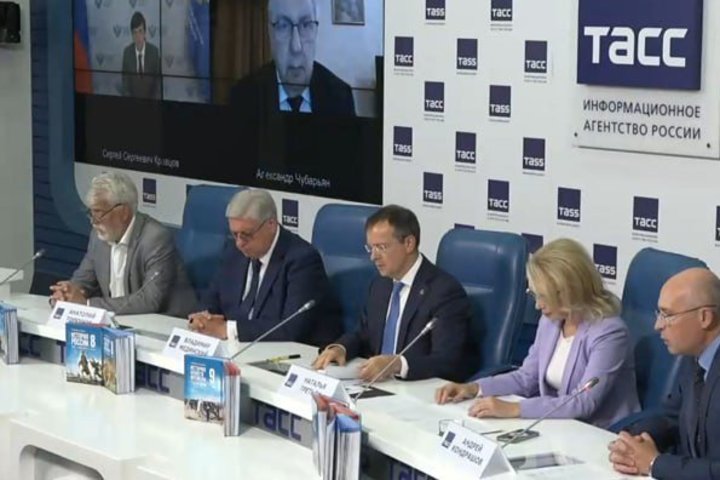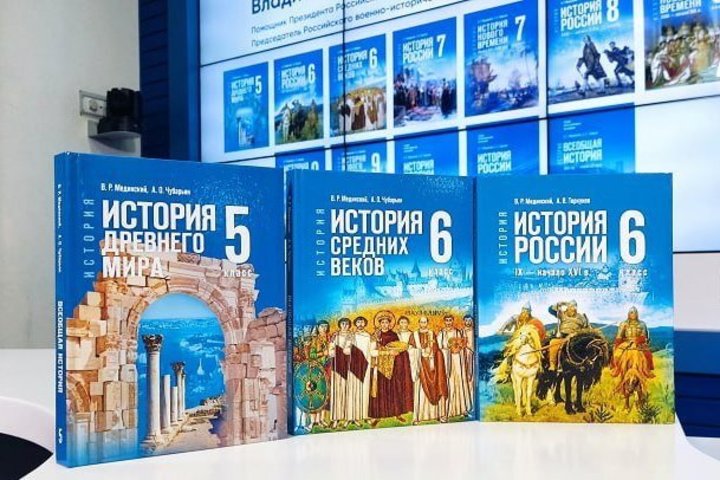New history textbooks: ‘Russia is stopping being a country with an unpredictable past’
Russian Education Minister Sergey Kravtsov and Vladimir Medinsky presented a new line of history textbooks
In 2013, Vladimir Putin ordered developing a single line of history textbooks that would reflect the chronology of events and their official assessment. Last year, the Ministry of Education released textbooks for grades 10-11, and on 30 August, journalists were presented textbooks on history for grades 5-9.
209 rubles per textbook
In 2013, there were more than 50 recommended history textbooks, last year, there were already three. These were added the same unified textbook for senior grades, which was prepared in four months and tested during the last academic year. According to Minister of Education of the Russian Federation Sergey Kravtsov, the new textbooks on Russian history and world history for grades 5-9 were based on the best of the previous editions. The information in the new textbooks was summarised and supplemented.
The price of state textbooks in hardcover, taking into account delivery to the regions, will be 209 rubles. Kravtsov noted that the previous editions in paperback cost about a 1,000 rubles.

Textbooks for grades 5-9 were compiled according to the same principle as last year for grades 10-11. There appeared QR codes in the textbooks with a link to archives, museum websites, and films.
“Many museum representatives said that since the introduction of textbooks for grades 10-11, the number of visits to websites has noticeably increased. That means that after learning this or that material, children turn to the original source, with the help of which they can expand the material, gain additional knowledge,” noted Sergey Kravtsov.
The testing of the new line of history textbooks will begin in September in different regions of Russia. Based on the results, clarifications will be made if necessary. And already in December, Kravtsov plans to include state history textbooks in the federal list, so that from 1 September 2025, Russian schools will be able to teach children using them.
Sergey Kravtsov said that work is underway in parallel to improve the qualifications of teachers. Therefore, he does not see any problems with preparing teachers to use the new teaching aid in their work.
16 textbooks with a “different conceptual approach” in 1.5 years
After the announcement of the new textbooks, a joke appeared on the Internet that from 2 September, Russia will stop beaing a country with an unpredictable past. Aide to the President of the Russian Federation and Chairman of the Russian Military Historical Society Vladimir Medinsky tried to clarify all the unclear points related to the new history textbooks.
Medinsky said that the work on the textbooks lasted 1.5 years, during which 16 volumes were prepared, 12 of which were school textbooks for grades 5 through 11, and three volumes for those receiving secondary vocational education.
“First of all, we worked on the existing base. But a lot was added, revised and processed. And most importantly, a different conceptual approach was proposed. The new textbooks are modern, they integrate general and national history as much as possible. This textbook is not a set of theses to memorise or a short course. This textbook is a window into the world of history, an invitation to discussion and a journey into this wonderful old world, the world of the deeds, exploits and labours of our ancestors,” said Vladimir Medinsky.
For all 16 volumes of the new textbooks, they tried to maintain a single visual solution
For all 16 volumes of the new textbooks, they tried to maintain a single visual solution. As Medinsky stated, “the appearance of the textbooks conveys the view of the authors' view on understanding the era that is reflected in this volume.” Each textbook also has maps that relate to a certain era. For some reason, according to Medinsky, it was difficult to make them, although similar maps are in previous textbooks and in outline maps on history.
Medinsky also spoke about how the images for the covers of the textbooks were selected:
“We believe that the study of history should not divide peoples and countries, not look for some wormholes, turning points, reasons for old conflicts. At least, not focus attention and give examples of the desire for peace, cooperation, peaceful competition. For example, in the textbook covering the second half of the 20th and early 21st centuries, we show a fragment of the famous match between the USSR and Canada.”
In the textbook covering the second half of the 20th and early 21st centuries, a fragment of the famous match between the USSR and Canada is shown, Medinsky said
The creators of the textbooks decided to show bridges on all the covers, which are reflected as ”symbols of the engineering of their time.” And the bridges are also intended to reflect the idea that “history, like a bridge, unites, history should help build bridges of cooperation.”
What has changed
As for the content of the textbooks, there have been significant changes. For example, in the textbooks on ancient history, in addition to Ancient Greece and Ancient Rome, they added mentions of Arkaim in Chelyabinsk region, the policies of the Northern Black Sea region, the Bosporan Kingdom, Derbent, the site of an ancient man in Voronezh region, etc.
In addition, a detailed list of recommended literature was added to each textbook. And they also changed the historical periods.
“We have moved away from the Western mechanistic periodisation of history imposed on us in the 1990s. The new era, according to the Eurocentric model of teaching in Western Europe, begins in 1492. This is the date of Columbus' discovery of America. But Russian history was thus torn apart, because the end of the 15th century was the period of the reign of Ivan III, and then his son Vasily III, who continued his father's policy until 1533. Why tear up history halfway through the reign and start teaching it in the next grade is completely unclear. That's why Ivan III and Vasily III were left in history textbooks for grade 6,” Vladimir Medinsky noted.
The new textbooks added mentions of Arkaim in Chelyabinsk region, the policies of the Northern Black Sea region, the Bosporan Kingdom, Derbent, the site of an ancient man in Voronezh region, etc
The chronological framework has also been shifted in textbooks for grade 8. It begins with the accession of Peter I and goes up to 1825, including the Decembrist uprising. In grade 9, more attention will be paid to the 19th century, where the periodisation begins in 1825 and ends in 1914. In the general history textbook for grade 8, the period ends in 1815, when the Vienna Congress took place. In the next textbook, the authors examined the 19th century and the colonial policy of Western countries in detail.
According to Medinsky, the language of presentation in the new textbooks is academic and strict but not complicated. How the controversial moments in Russian history are shown in the new textbooks was not discussed at the press conference.
Russian Education Minister Sergey Kravtsov said that a new social studies textbook for grade 9 is already ready and that they have begun developing textbooks for grades 10-11. It is expected that their manuscripts will appear at the end of this year.
Ekaterina Petrova is a book reviewer of Realnoe Vremya online newspaper, the author of Poppy Seed Muffins Telegram channel and founder of the first online subscription book club Makulatura.
